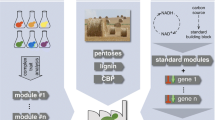Abstract
The tremendous body of knowledge about genetics, cell biology, and metabolism of Saccharomyces cerevisiae, as well as its long history and robustness in industrial fermentations, have made this yeast one of the most popular microbial cell factories. Novel genetic tools have enabled the rapid construction of strains producing various platform chemicals, fuels, or pharmaceuticals. The relevance of synthetic biology approaches, such as the construction of fully synthetic genomes and artificial cellular compartments are not only relevant for biotechnological applications but can also lead to new insight into basic principles of life.
Article PDF
Similar content being viewed by others
Avoid common mistakes on your manuscript.
Literatur
Doudna JA, Charpentier E (2014) Genome editing. The new frontier of genome engineering with CRISPR-Cas9. Science 346: 1258096
Zhang W, Mitchell LA, Bader JS et al. (2020) Synthetic genomes. Annu Rev Biochem 89:77–101
Jansen MLA, Bracher JM, Papapetridis I et al. (2017) Saccharomyces cerevisiae strains for second-generation ethanol production: From academic exploration to industrial implementation. FEMS Yeast Res 17: fox044
Sauer M, Porro D, Mattanovich D et al. (2008) Microbial production of organic acids: expanding the markets. Trends Biotechnol 26: 100–108
Paddon CJ, Keasling JD (2014) Semi-synthetic artemisinin: a model for the use of synthetic biology in pharmaceutical development. Nat Rev Microbiol 12: 355–367
Nielsen J, Larsson C, van Maris A et al. (2013) Metabolic engineering of yeast for production of fuels and chemicals. Curr Opin Biotechnol 24: 398–404
Cravens A, Payne J, Smolke CD (2019) Synthetic biology strategies for microbial biosynthesis of plant natural products. Nat Commun 10: 2142
Grewal PS, Samson JA, Baker JJ et al. (2021) Peroxisome compartmentalization of a toxic enzyme improves alkaloid production. Nat Chem Biol 17: 96–103
Reifenrath M, Oreb M, Boles E et al. (2020) Artificial ER-derived vesicles as synthetic organelles for in vivo compartmentalization of biochemical pathways. ACS Synth Biol 9: 2909–2916
Reifenrath M, Tripp J, Oreb M et al. (2016) Synthetische subzelluläre Kompartimente in eukaryotischen Zellen. BIOspektrum 22: 374–377
Funding
Open Access funding enabled and organized by Projekt DEAL.
Author information
Authors and Affiliations
Corresponding author
Additional information
Mislav Oreb 1996–2002 Studium der Biologie an der Universität Braunschweig. 2004`-2008 Doktorand bei Prof. Dr. E. Schleiff an der LMU München und an der Universität Frankfurt a. M. 2009`-2010 Postdoc bei Prof. Dr. T. Hugel an der TU München. Seit 2010 Gruppenleiter an der Universität Frankfurt a. M. bei Prof. Dr. E. Boles.
Joanna Tripp 1994–2000 Studium der Biologie an der Universität Frankfurt a. M.; dort 2000`-2005 Doktorandin bei Prof. Dr. L. Nover. 2005`-2007 Postdoc bei Prof. Dr. K. Keegstra am MSU-DOE Plant Research Laboratory, East Lansing, USA. 2008`-2013 Wissenschaftliche Mitarbeiterin bei Prof. Dr. E. Schleiff an der Universität Frankfurt a. M. Seit 2014 Wissenschaftliche Mitarbeiterin an der Universität Frankfurt a. M. bei Prof. Dr. E. Boles.
Rights and permissions
Dieser Artikel wird unter der Creative Commons Namensnennung 4.0 International Lizenz veröffentlicht, welche die Nutzung, Vervielfältigung, Bearbeitung, Verbreitung und Wiedergabe in jeglichem Medium und Format erlaubt, sofern Sie den/die ursprünglichen Autor(en) und die Quelle ordnungsgemäß nennen, einen Link zur Creative Commons Lizenz beifügen und angeben, ob Änderungen vorgenommen wurden. Die in diesem Artikel enthaltenen Bilder und sonstiges Drittmaterial unterliegen ebenfalls der genannten Creative Commons Lizenz, sofern sich aus der Abbildungslegende nichts anderes ergibt. Sofern das betreffende Material nicht unter der genannten Creative Commons Lizenz steht und die betreffende Handlung nicht nach gesetzlichen Vorschriften erlaubt ist, ist für die oben aufgeführten Weiterverwendungen des Materials die Einwilligung des jeweiligen Rechteinhabers einzuholen. Weitere Details zur Lizenz entnehmen Sie bitte der Lizenzinformation auf http://creativecommons.org/licenses/by/4.0/deed.de.
About this article
Cite this article
Oreb, M., Tripp, J. Maßgeschneiderte Hefezellen für biotechnologische Anwendungen. Biospektrum 28, 14–17 (2022). https://doi.org/10.1007/s12268-022-1704-y
Published:
Issue Date:
DOI: https://doi.org/10.1007/s12268-022-1704-y




